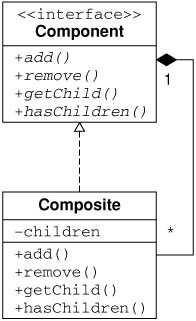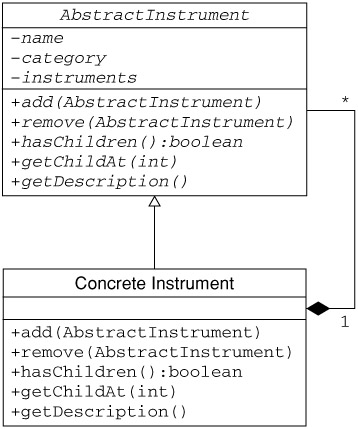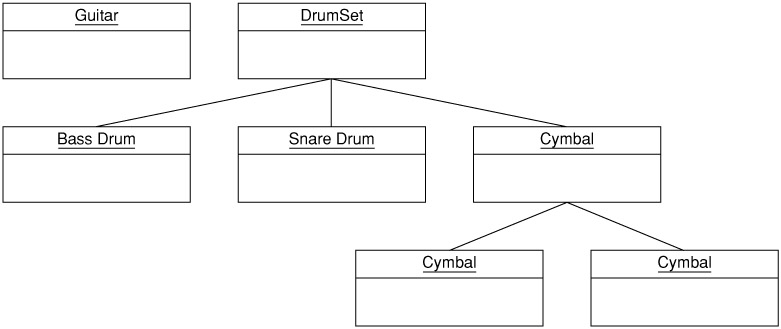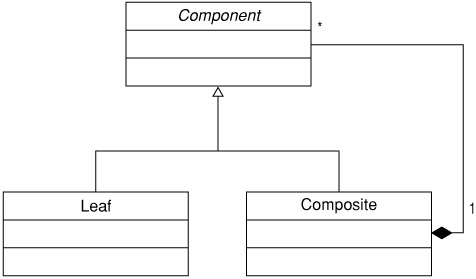The Composite Pattern
The Composite Pattern
You've already had a little experience with one pattern the composite from the Instrument interface in Chapter 2, "Unified Modeling Language (UML)." Take a look at the class diagram again in Figure 4-1.

Figure 4-1
Figure 4-1 shows that a DrumSet object can be composed of both Drum and Cymbal objects. Drum and Cymbal can be thought of as children of the DrumSet object. A DrumSet can be composed of any number of Drums and Cymbals. Notice, though, that both DrumSet and its children are all of the same type, namely Instrument. When a client object interacts with DrumSet, it does so through the same interface as it would to interact with its children. This relationship is known as the composite pattern.
Figure 4-2 shows the general case for the composite.

Figure 4-2
The composite pattern has two parts: the Component abstract class and the Composite, which is a concrete implementation of the Component class. All Composite objects descend from the abstract Component class. Any Component can contain other Components. A Component containing other components can be thought of as a Composite. A Component with no children can be thought of as an empty Composite.
| Note | Some implementations of Composite make a distinction between Composite objects and Leaf objects. Leaf objects are Components that can't contain children. For this example, all Components have the ability to be Composites. |
Moving back from the general case, it will be necessary to make a change in the design and switch the Instrument interface to an abstract class. Interfaces and abstract classes are similar because neither one can be used directly to instantiate an object. The key difference is that an abstract class can have some fully implemented methods, whereas interfaces just have method declarations. Use abstract classes when you want to maintain the same methods in all your subclasses but have some general functionality that can be shared by the subclasses. Use interfaces when the implementations will differ across most or all the methods in subclasses. Figure 4-3 shows the new class diagram. Note that abstract class diagrams are indicated with italics.

Figure 4-3
The association line indicates that each concrete instance of AbstractInstrument may contain any number including zero of other instances of AbstractInstrument.
Implementation
The following PHP code shows the implementation of the composite pattern.
<html> <body> <head> <style> body {font : 12px verdana; font-weight:bold} td {font : 11px verdana;} </style> </head> <?php abstract class AbstractInstrument { private $name; private $category; private $instruments = array(); public function add(AbstractInstrument $instrument) { array_push($this->instruments, $instrument); } public function remove(AbstractInstrument $instrument) { array_pop($this->instruments); } public function hasChildren() { return (bool)(count($this->instruments) > 0); } public function getChild($i) { return $instruments[i]; } public function getDescription() { echo "- one " . $this->getName(); if ($this->hasChildren()) { echo " which includes:<br>"; foreach($this->instruments as $instrument) { echo "<table cellspacing=5 border=0><tr><td> </td><td>-"; $instrument->getDescription(); echo "</td></tr></table>"; } } } public function setName($name) { $this->name = $name; } public function getName() { return $this->name; } public function setCategory($category) { $this->category = $category; } public function getCategory() { return $this->category; } } class Guitar extends AbstractInstrument { function __construct($name) { parent::setName($name); parent::setCategory("guitars"); } } class DrumSet extends AbstractInstrument { function __construct($name) { parent::setName($name); parent::setCategory("drums"); } } class SnareDrum extends AbstractInstrument { function __construct($name) { parent::setName($name); parent::setCategory("snare drums"); } } class BaseDrum extends AbstractInstrument { function __construct($name) { parent::setName($name); parent::setCategory("base drums"); } } class Cymbal extends AbstractInstrument { function __construct($name) { parent::setName($name); parent::setCategory("cymbals"); } } $drums = new DrumSet("tama maple set"); $drums->add(new SnareDrum("snare drum")); $drums->add(new BaseDrum("large bass drum")); $cymbals = new Cymbal("zildjian cymbal set"); $cymbals->add(new Cymbal("small crash")); $cymbals->add(new Cymbal("large high hat")); $drums->add($cymbals); $guitar = new Guitar("gibson les paul"); echo "List of Instruments: <p>"; $drums->getDescription(); $guitar->getDescription(); ?> </body> </html>
Notice that all the concrete instruments, such as DrumSet and Guitar, descend from the AbstractInstrument class. Also notice that all the subclasses inherit the implemented methods in the abstract class. To implement the getDescription() , the current instrument is checked to see whether it has children. If it does, the method is called recursively until it travels through the entire tree.
Historically (in PHP4), the & symbol caused the object, in this case of type AbstractInstrument, to be passed by reference:
public function add(AbstractInstrument & $instrument) { 
